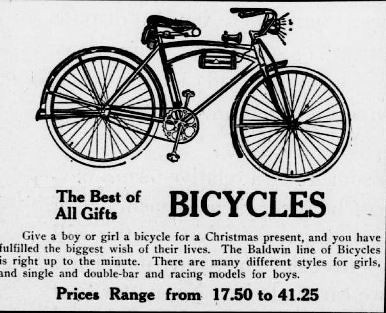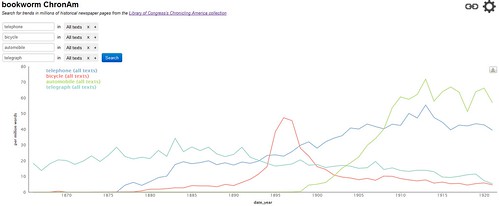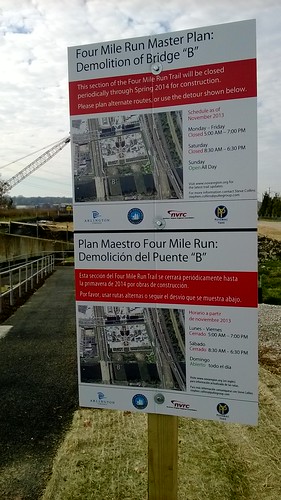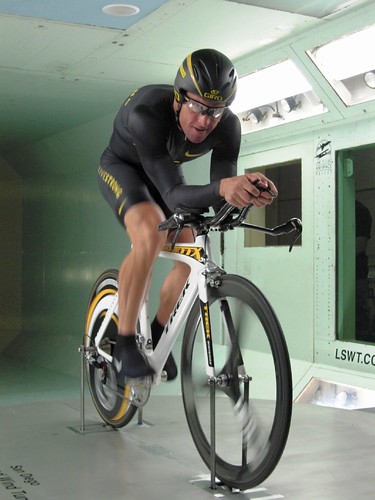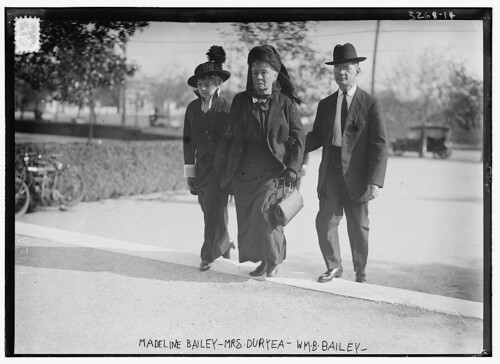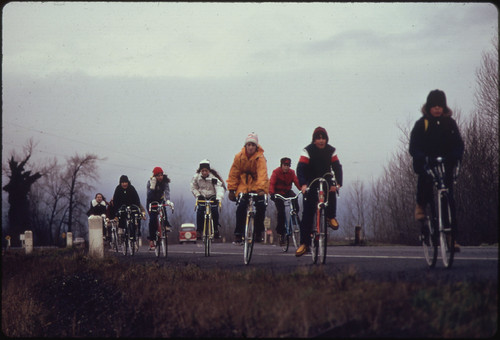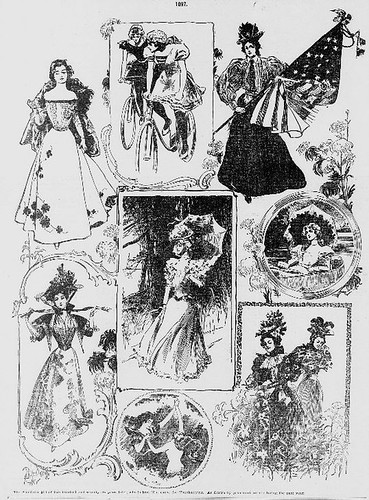This long list of accidents involving bicycles in New York City for the month of July, 1897 is from the New York Sun newspaper. I reproduce the text (cleaned up from what is in the source) from the
full article. No illustrations were provided. Normally I do not fill a blog with the entire text taken from an article like this, but at least for me reading all of this gives an interesting picture of that time, particularly when compared to how such things transpire these days.
Some background may help - the actors are generally pedestrians, bicycle riders, drivers of horse-drawn vehicles, and a few runaway horses. In particular the word "rider" is always used to refer to cyclists, particularly in the phrase, "rider arrested." And the word "driver" is always referring to someone operating a horse drawn vehicle since at this time there were no automobiles, again as in the phrase, "driver arrested."
Despite the title of the article, that to me suggested wheelmen and wheelwomen were at fault in all the incidents described, the blame is sometimes ascribed to the drivers of vehicles or to events beyond anyone's control, for example with runaway horses or a bicycle that has a fork break and falls to the street. Where fault was found by the police on the spot, it is noteworthy that the party at fault, whether a rider or driver, is immediately arrested, sometimes after being chased. Some of the cyclists are not arrested because they escape. And in this list, riders are considered to have been at fault far more than drivers.
Some cyclists are described as "scorchers" - I
described scorchers in an earlier blog post - this term was used to describe reckless speedster cyclists during the 1890s.
Some of the language in the piece reflects a different approach to journalism - some individuals are labeled as "fat" or "stupid," for example. The article appears to be intended to have a certain entertainment value in its approach to the subject (or something like entertainment).
JULY'S BICYCLE RECORD - Misadventures of Wheelmen and Wheelwomen and Accidents Caused by Them
The list of bicycle accidents that occurred in this city during July is long, despite the fact that for more than two weeks most of the wheelers were kept indoors by almost incessant rain. A surprising thing about the month's casualties is that while the cycling season is well advanced the number of careless and unskilful riders doesn't seem to diminish. Fewer of the accidents in July can be counted a unavoidable than in June, although in some cases it is difficult to determine by the brief report obtainable whether or not the mishap could, under the circumstances, have been prevented. The habitual scorcher certainly took a rest last month, and was probably not responsible for more than one-tenth of the damage done. Following is a summary of the accidents reported:
A peddler's wagon runs into a wheelwoman, who is thrown from her saddle. 8he falls into the arms of a bike cop and escapes injury. The bicycle is smashed and the driver locked up after a lively chase.
A scorcher knocks down an elderly man, whose collar bone is broken by the fall. The victim is taken to a hospital and declines to make a complaint against the wheelman.
A cab driver runs down a wheelwoman and one of the wheels of the cab passes over her head, breaking her nose and fracturing her skull in several places. She is taken home and the cabman is arrested.
An elderly woman is knocked over by a wheelman and so severely cut and bruised that she is taken to a hospital. Cyclist arrested.
A seven-year-old boy, while playing in the street, is run over by a cyclist, receives a scalp wound, and is sent to a hospital.

The entire middle column is made up of this list of bicycle accidents for July 1897 in NYC
The forks of a bicycle break on Eighth avenue and the rider is thrown heavily against the curb. He is taken to a hospital.
A boy cyclist knocks down three-year-old girl who is playing in the street, the child is severely injured about the head and shoulders and is taken to a hospital. Boy arrested.
A woman is struck by a wheelman, receives a broken wrist and scalp wounds, and is taken to a hospital. Rider arrested.
One wheelman collides with another, is thrown, and receives a bad scalp wound. He is taken to a hospital.
A young woman is run down by a wheelman and has her left thigh and arm broken. Rider arrested.
A wheelman's pedal strikes a curbstone and he is thrown heavily to the pavement, but escapes with a few scratches.
A tandem collides with a buggy at the Central Park Circle and is smashed. The cyclists, a man and a women, are thrown off, but escape injury. The accident said to be due to the torn up condition of the Circle.
A reckless young wheelman runs into a six-year-old boy, whose right leg is injured and left ear badly torn. Rider arrested.
A seven-year-old girl playing in front of her home is run over by a wheelman, but not seriously hurt. Rider arrested.
A six-year-old girl is struck by wheelman; her leg is broken and she is taken to a hospital. Rider arrested.
A young wheelwoman runs into an ambulance, which comes upon her suddenly. The wheel is smashed, but its rider isn't hurt and the driver isn't blamed.
A truckman corners a wheelman and runs over his bike, smashing it. The cyclist barely avoids being run over himself, and, it is said, is told by the truck's owner that 'tis a pity his neck isn't broken as well as his wheel.
A wheelman in trying to pass in front of a wagon, hits its shaft and strikes his eye against a harness buckle, injuring the eye badly.
A woman is knocked down and run over by a wheelman, has her cheek badly cut and is taken to a hospital. Rider arrested.
A wheelman is crowded off his machine by a team of horses drawing a heavy wagon. A wheel passes over his ankle, and the driver, in backing the team, rolls the wheel over the cyclist's ankle a second time. The injured man is taken to a hospital and the driver is arrested.
A man is knocked down and run over by a wheelman. The pedestrian receives contusions on both knees and on the left arm and is taken away in an ambulance. Rider arrested.
A driver runs over ten-year-old boy cyclist, who is badly cut and bruised about the head. Driver arrested.
A monkey-backed scorcher, riding on a cable slot with his head down, bucks into a truck and is thrown violently into the street. He is picked up in a semi-conscious state, with his head badly cut, and is treated by an ambulance surgeon.
A wheelwoman's bike slips on a wet pavement and she is thrown off. Her elbow is cut and she is bruised in several places. An ambulance is called and the surgeon dresses the woman's wounds and sends her home.
Another wheel slips on a wet pavement, and the rider, a woman, is landed in the street with great force. Her left ankle is fractured and she is taken to a hospital, where she is likely to remain for several weeks.
An engaged couple on a tandem are run into by a lad driving a grocery wagon and are thrown, one of the wagon wheels passing over the young woman's body. She is severely bruised and receives a bad scalp wound, while the man escapes with slight injuries. Driver is blamed, and is locked up after a chase.
A coal cart and a wheelwoman collide on the Boulevard and the cyclist is knocked out, but not seriously hurt. Bystanders blame the driver.
A young couple, man and woman, are riding a tandem in Central Park, when the handle bar parts and the man is pitched forward onto the fork and receives a slight wound on his right side. He is taken to a hospital. The woman is not much hurt.
A four-year-old girl is knocked down by a scorcher, and has her right leg broken. The scorcher doesn't stop to investigate.
A young woman, after spurting to get past a wagon, strikes against a curb before she is able to stop. She is thrown heavily to the sidewalk, her head striking against a hydrant. She goes home in a cab.
A wheelman, in anticipation of a happy event expected hourly to take place at home, scorches down Second avenue, runs over a six-year old boy, and is locked up. The boy is taken to a hospital practically unhurt. The cyclist is released, but was too late.
An elderly woman is knocked down and run over by a wheelman on Eighth avenue; her thigh is fractured, and she is taken to a hospital in a serious condition Rider arrested.
A wheelwoman walking beside her bicycle is knocked down by a runaway horse. She is unconscious, but suffers only slight injury.
A wheelman riding up Fifth avenue, with his back curved like a dromedary's and his nose almost touching the handle bar, fails to turn the corner, dashes into the sidewalk and strikes a girl, knocking her down. She is rendered unconscious, but isn't much hurt. The rider is thrown by the collision, but immediately remounts and scorches away.
A wheelwoman falls from her machine on Fifth avenue, receives a contusion of the right elbow and it taken home.
A wheelwoman loses control of her machine on Eighth avenue and falls, fracturing her left ankle. She is removed to a hospital.
A young wheelman collides with a truck on Third avenue, is thrown, and lacerates his hand badly. He refuses to make a complaint.
Two wheelmen riding rapidly on the Boulevard collide, and are thrown to the ground. Neither is much hurt, and they ride away after a brief but heated argument.
In cleaning his bike a wheelman's forefinger gets caught in the sprocket wheel and is cut off. The wound is dressed by an ambulance surgeon.
A wheelman is overcome by the heat and falls from his machine, striking on hit head. He is picked up unconscious and removed to a hospital suffering from concussion of the brain.
A cab driver runs into and knocks down a boy cyclist, badly cutting the lad's left knee and arm. The cabman lashes his horse and escapes.
A bicyclist is taken ill and falls, fracturing his skull. He is taken to a hospital and his injuries are probably fatal.
A cab strikes a boy cyclist, who is knocked under the horse's feet and barely escapes being run over. He is badly cut and is taken home in an ambulance. Driver hurries away.
A middle-aged woman learning to wheel becomes over-confident of her skill and turns too short in a bicycle academy. Her machine slips and she falls on her left foot, breaking her ankle. She is taken to a hospital.
In getting off a street car a man steps in front of a rapidly moving bicycle, is knocked about five feet, and has his left leg broken. The wheelman is thrown, but remounts and spurts away.
A stupid driver proceeds uptown on the wrong side of Eighth avenue and runs into a wheelwoman, who is thrown into the street, but is not much hurt. Her wheel is completely wrecked. Driver is locked up.
A middle-aged wheelman is run into on Eighth avenue by another wheelman and knocked off his machine. He falls under a truck and has his right arm broken. In explanation, rider No. 2 said: If I hadn't run against you I would have fallen myself." The injured man is taken to a hospital, but refuses to make a complaint against the other rider.
A fat wheelman and a slender wheelwoman, in trying to escape from a runaway horse, collide on the Boulevard and both riders strike the pavement on all fours. They suffer only from fright. A bike cop stops the horse.
In June several wheelmen were struck by cable cars at "Dead Man's Curve" and other places but it is noticeable from the above sketch that the cable road was responsible for none of the accidents to wheelmen in July. Whether that fact is due to the warning which THE SUN gave to the bicycles last month or to the slower speed at which the cars have lately rounded the curves, is left to the reader's judgement. A striking feature of last month's record is to be found in the theo largo number of children who were run down while playing in the street. And in this regard a hint may be wisely taken by parents and wheelmen alike. It appears that the troublesome, reckless driver so much complained of by cyclists came near smashing his previous records in July, a very large fraction of the month's accidents being attributed to his long-felt want of good sense.

